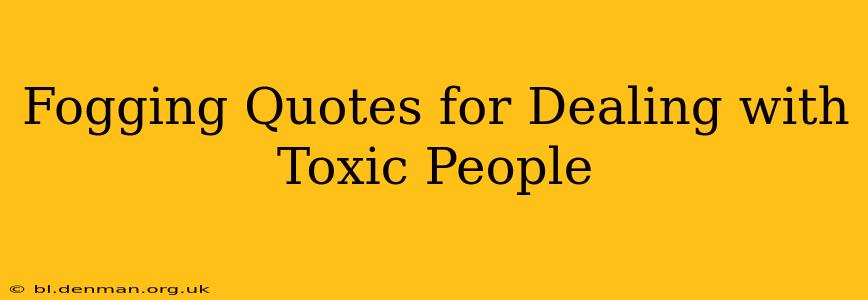Dealing with toxic people can feel like navigating a minefield. Their negativity, criticism, and manipulations can drain your energy and leave you feeling emotionally exhausted. One powerful technique to disarm these interactions and protect your mental wellbeing is fogging. This article explores fogging quotes and strategies, providing you with the tools to navigate challenging conversations with grace and resilience.
What is Fogging?
Fogging is a communication technique that acknowledges the other person's perspective without agreeing or disagreeing directly. It's like creating a mental "fog" around their accusations or criticisms, making it difficult for them to get a reaction from you. Instead of engaging in a conflict, you diffuse the situation by validating their feelings while maintaining your boundaries. This approach is particularly useful when dealing with individuals who are prone to manipulation or aggression.
Key Fogging Quotes and Phrases
These quotes illustrate the core principles of fogging:
- "You might be right about that." This simple phrase acknowledges their perspective without confirming or denying its validity.
- "That's interesting." This neutral response avoids conflict and encourages the other person to elaborate, providing you with more information to understand their point of view.
- "I can see why you feel that way." This statement shows empathy and understanding, even if you don't agree with their assessment.
- "I understand your perspective." Similar to the previous example, it demonstrates that you're listening and trying to comprehend their position.
- "I'll take that into consideration." This response indicates that you're receptive to their feedback without committing to any specific action.
How to Effectively Use Fogging Quotes
The effectiveness of fogging relies on your tone and body language. Even the most neutral phrase can escalate the situation if delivered aggressively. Maintain a calm, neutral demeanor. Avoid eye-rolling, sighing, or other nonverbal cues that might be interpreted as dismissive.
Here's a breakdown of the process:
- Listen actively: Pay attention to what the toxic person is saying, not just waiting for your turn to speak.
- Identify the core issue: Determine the underlying emotion or concern driving their behavior.
- Choose an appropriate fogging quote: Select a response that acknowledges their perspective without engaging in an argument.
- Deliver the response calmly: Use a neutral tone and maintain appropriate body language.
- Maintain boundaries: While using fogging, remember to uphold your personal boundaries. You don't need to justify your actions or tolerate abusive behavior.
Why Fogging is Effective
- Reduces conflict: By avoiding direct confrontation, fogging decreases the likelihood of escalation.
- Preserves your emotional energy: It prevents you from being dragged into unproductive arguments.
- Disarms manipulators: Toxic individuals thrive on reactions. Fogging deprives them of the fuel they need to continue their behavior.
- Allows for clear thinking: It provides space and time to think rationally and formulate a thoughtful response.
H2: What are some examples of fogging in action?
Scenario: A coworker constantly criticizes your work, saying, "This report is sloppy and full of errors!"
Fogging response: "I can see why you feel that way. I'll review it again to ensure it meets the standards."
Scenario: A family member makes hurtful comments about your personal life, stating, "Your choices are just terrible!"
Fogging response: "I understand your perspective. Ultimately, these are my decisions to make."
H2: Does fogging always work?
No method works perfectly every time. Fogging is most effective when dealing with individuals who are looking for a reaction. If you're facing someone who is aggressively hostile or abusive, it may be necessary to set stricter boundaries or seek external support.
H2: What if fogging doesn't resolve the issue?
If fogging doesn't resolve the issue, it's crucial to consider other strategies, such as:
- Setting clear boundaries: Communicate your limits clearly and firmly.
- Limiting contact: Reduce your interactions with the toxic person.
- Seeking support: Talk to a trusted friend, family member, therapist, or counselor.
Fogging is a valuable tool for managing interactions with toxic individuals. By using these techniques, you can protect your emotional well-being and navigate challenging situations with greater self-assurance. Remember to prioritize your mental health and seek additional support when necessary.

